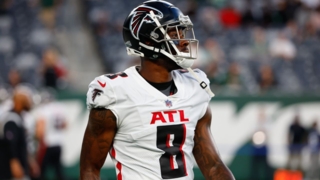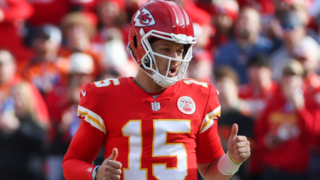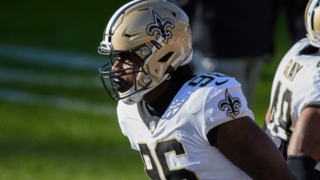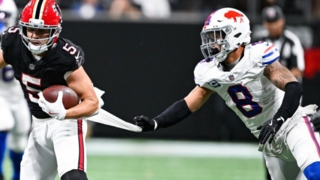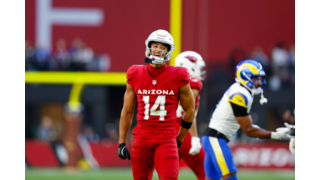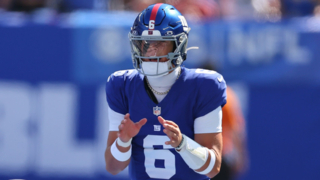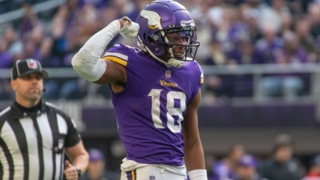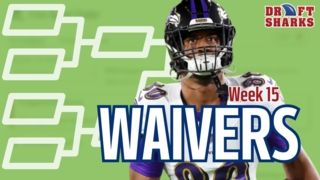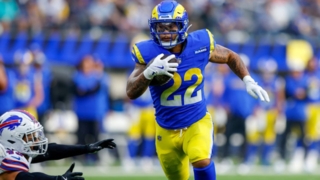2016 Breakout Player

Wouldn't it be nice if you could snatch a breakthrough player who has already showed what he can do in the league?
That's what you'll get if you draft our 2016 Breakout Pick.
This former early-round NFL Draft selection probably still makes some owners uneasy at fantasy football draft time. But we love his talent, his situation looks strong, and he should find plenty of motivation in 2016. He has delivered value to fantasy owners for multiple seasons, but he hasn’t quite reached his ceiling yet.
Hell, he might not have even gotten close to it.
Best of all, he’ll present value to you on draft day, with a solid floor (barring some freak injury) that he has already displayed.
But don’t just take our word for it. This year’s choice comes with the strong recommendation of his head coach and GM …
History
Many of you will see Michael Floyd’s name and think about how he let you down at some point in the past. But in full-season terms, that could have only been true in 2014.
As a rookie, Floyd entered the league in 2012 and came off the board 52nd among WRs on average in MyFantasyLeague.com 12-team redraft leagues (across formats, in post-Aug. 1 drafting; MFL10s did not exist then). He finished that season 35th among PPR wideouts and 36th in non-PPR.
Fantasy drafters elevated Floyd to 42nd among WRs at draft time the following year (same MFL settings), and the 2nd-year Cardinal delivered a WR25 finish in PPR and WR23 in non-PPR.
That got many of us excited about his prospects for that saliva-inducing 3rd year, and MFL10 drafters grabbed Floyd as the #17 WR off the board, on average. If you joined that group, he let you down -- without even a worthwhile injury excuse to blame. Floyd finished 44th in PPR scoring and 32nd in non-PPR, while appearing on the injury report just twice (“probable” both times).
So the excited folks of 2014 sneered at the prodigal wideout last summer, especially after he dislocated 3 fingers in early August. That cost Floyd the preseason, helped him rank just 37th among WRs in MFL10 post-8/1 ADP and then slowed his early-season progress. Floyd still managed to finish 38th among PPR receivers and 34th in non-PPR.
But his value proved much greater if you figured out when to use him.
The cracks before the breakthrough
Floyd saw just 1 target each of the first 2 games and finished 4 of the first 5 with 1 reception or fewer. He topped 5 targets just once over the first 5 games and didn’t do so in consecutive weeks until the middle of Arizona’s season. It was Week 8 before Floyd reached 60 yards in a game. But from that point on … well, let’s ask HC Bruce Arians.
"If he wouldn't have broken his hand, I think he would have had a 1,500-yard year," Arians said in January, per The Associated Press. "He was having a great camp, and he's having a hell of a season, especially the second half of the season."
The aforementioned Week 8 touched off a 9-game stretch during which Floyd produced 5 games of 100+ yards. From Week 8 on, he ranked 19th among all fantasy WRs across formats -- despite missing 2 weeks in that stretch (1 for the bye; 1 for injury). Floyd ranked 11th in non-PPR points per game and 12th on the PPR side.
From Week 13 on -- the game after he returned from injury -- Floyd ranked 16th among WRs across formats, despite scoring only 1 TD among the 5 games.
Keeping it in perspective
It’d be easy to point to this span as another example of overrating a small sample, but that’s where the numbers of his previous 3 seasons come in. Floyd didn’t come out of nowhere in the 2nd half of 2015. He’s a former 13th overall pick who finally seemed to be delivering on his promise. And there’s evidence beyond Floyd’s 2nd-half numbers.
“Mike has made tremendous strides, particularly this past year, not only from a skill-set standpoint but from a maturity standpoint,” GM Steve Keim told the team website in February. “His work ethic, his passion for the game, I think he took it to another level.”
If you wondered why Floyd let you down in 2014, then Keim seemed to answer the question right there. The young wideout -- he was 24 when the 2014 season began -- apparently wasn’t taking his craft seriously enough. Throw in Larry Fitzgerald, a then-rookie John Brown and a pair of Carson Palmer injuries, and you have a great recipe for a season of disappointment.
A more mature Floyd now heads into the final year of his rookie contract. He shouldn’t lack for motivation. And he has never lacked for talent.
"He brings a guy that's physical (as a blocker) in the run game,” Palmer told the AP in January. “He's physical with the ball in his hands. He's a guy that can make the play with the ball in his hands after the catch, and break a tackle here and there. He's a mismatch, week in and week out. It doesn't matter who the corner is."
Palmer also mentioned how the focus that defenses place on Fitzgerald opens up 1-on-1 opportunities for Floyd, which he’s capable of exploiting.
The situation
Opportunity might be the biggest question facing Floyd in 2016. Fitz and Brown both beat him in targets and targets per game last season. Fitzgerald’s 9.1 per week for the year dwarfed Floyd’s 5.9. But things turned the other way down the stretch.
Over the final 7 games of 2015 -- including the playoffs -- Floyd led all 3 Cardinals WRs in targets: 56 to 54 (Brown) and 53 (Fitz). He beat Fitzgerald in targets in 5 of those 7 contests.
That still makes for a small sample, but it’s important because of the injuries that impacted Floyd early. Beyond the broken hand/dislocated fingers, he also lost a game-plus to a hamstring injury and landed on the injury report with late-season knee trouble. We can’t know how much those issues affected Floyd beyond the missed time, but it’s fair to say they impeded his consistency -- at least in playing time.
That late-season stretch also coincided with Fitzgerald’s numbers turning far less efficient. The veteran averaged 12.7 yards per catch through the 1st 10 games, with 7 total TDs and 7.3 receptions per outing. Over his final 6 regular-season games, Fitz averaged just 6.0 catches and 8.0 yards per reception. Even if you throw in the 2 playoff contests -- including his big night to beat Green Bay -- Fitzgerald averaged merely 10.3 yards per catch.
We’re not saying he suddenly couldn’t run so far. Rather, Arizona appeared to consistently work Fitzgerald on shorter routes once a healthier Floyd was available. For the year, Fitzgerald compiled a career-low 11.1 yards per reception. His 6.8 receptions per week, on the other hand, marked a career high -- which suggests lots of room for regression in 2016 (especially considering we already saw the rate come down late last season).
Brown, meanwhile, improved on his solid rookie performance. He raised his catch rate, yards per reception and TD total. But he also saw almost exactly the same number of targets despite playing 169 more snaps. Heading into his 3rd season, it’s certainly too early to say we’ve seen the ceiling on his target volume. But it also seems fair to expect another year in the 100-105 target range.
Where Brown particularly stepped up last year was in the red zone. He garnered 19 total targets there, according to Pro Football Reference, and scored 6 of his 7 TDs from the 20-yard line or closer. With all 3 WRs active for the final 6 regular-season games, Brown led the trio with 7 RZ targets, vs. 5 for Fitz and 2 for Floyd.
The offense, meanwhile, seems good for everyone involved.
The Cards ranked 1st in the league in yards and 2nd in scoring last season, the 1st time we had the combo of Arians, a healthy Palmer, a healthy running game and the 3 quality wideouts. Arizona proved efficient, too, leading the league in yards per play. That marked the 4th time in the past 5 years an Arians offense ranked among the top 12 in yards.
The passing volume could be better, as the Cards ranked just 19th, 15th and 17th in pass attempts the past 3 years. But 5 of Arians’ past 7 offenses have ranked top 11 in Pro Football Reference’s net yards per attempt, including 4 seasons among the top 9.
Even if the volume doesn’t increase, the production should remain strong as long as Palmer’s on the field.
TD upside?
Brown’s numbers might limit Floyd’s TD ceiling. But just like it’s too early to place the ceiling on Brown’s role, it’s also too early to say we know for sure how the Cards will act in the red zone.
Floyd hasn’t done a whole lot in that area so far, scoring 6 total RZ touchdowns over 4 seasons. But he tallied 37 total TDs across 4 college campaigns, including 9+ in each of his final 3 years. (That included a 7-game 2009.)
Floyd also profiles like a RZ target. Since 2000, there have been 142 player seasons of 10+ TD catches. Just 21 of those have come from players shorter than 6’ (such as John Brown), with Marvin Harrison responsible for 7 of those 21. Players 6’2 or taller have accounted for 92 of them, including 77 by players 6’3 or taller. (Floyd measured in 6’3 at the 2012 Combine but is listed at 6’2 on NFL.com right now.)
What does that all mean for Floyd vs. Brown? Perhaps nothing. Fitzgerald also fits the 6’3-plus mold.
The point is that TD-scoring wideouts tend to look like Floyd. Whether he has a 10+ TD season in his future or not, the 78th percentile height, 89th percentile weight and slightly-above-average vertical (53rd percentile) certainly don’t hurt him near the end zone.
Beyond the size of the receiver, volume unsurprisingly matters here as well. Of the 142 aforementioned 10+ receiving TD seasons since 2000, 86 came from players who caught 80+ balls. That’s about 61%. Eighty-eight of the seasons (62%) included 130+ targets.
Both of those levels sit above what we project for Floyd this season, but they’re not out of reach. The 56 targets we mentioned above from his final 7 games of last year average out to 8 a week. That’s 128 over a full 16 games. And if we believe the words of Arians and Keim, it’s not hard to see a few more targets going Floyd’s way in 2016.
Production without the TDs
Let’s not get any deeper into the TD talk. That’s a difficult stat to project. Instead, let’s turn to the yardage, which is where Floyd has already proved himself.
Now that Calvin Johnson and Malcom Floyd have retired, Michael Floyd ranks 5th among active players in yards per catch. Take out the 12.5 YPC of his rookie campaign, and Floyd would jump to 4th on the list. Of the 111 players who have ever caught 200+ passes over their 1st 4 seasons, only 27 have averaged more yards per catch than Floyd.
We mentioned above how Floyd hit 100 yards in 5 games last year, which beat his previous high by 2 games. Only 6 players posted more 100+ yard games, and all 6 of them ranked among the league’s top 8 in targets. (Floyd tied for 54th.) The other 5 players who matched Floyd’s 5 games all out-targeted Floyd as well, with Sammy Watkins the only other guy who garnered fewer than 105 looks. (Even Watkins beat Floyd 96-89 -- in 2 fewer games.)
Before 2015, there were 33 players from 2000-2014 who delivered 5+ games of 100+ receiving yards in a season by the 4th year of their careers. Eighteen of those players have repeated that feat at least 1 more time. Five others did so in 2013 or 2014 and enter 2016 younger than 28 (i.e. with plenty of time to do so again).
That leaves 8 other players who never repeated. Six of those guys ranked 31st or better among PPR wideouts the following season, including 4 guys who finished at WR23 or better. The other 2 players missed 8+ games the following year. Then David Boston ranked 17th in just 14 games the next season, and Javon Walker finished 12th.
The message: Guys who deliver yardage like that bring talent. Sure, some of them flamed out short of their career ceilings but not before helping fantasy owners in multiple seasons.
The new value range
A couple of years ago, a WR going late in Round 4 didn’t look like a special value, but that spot still finds Floyd going just 27th among wideouts in MFL public-league drafting right now.
As we mentioned above, Floyd has already finished 3 of his 4 seasons among the top 38 PPR receivers. The bottom of that range is going just 2 rounds later than Floyd’s ADP. So unless Floyd gets hurt -- and remember that he didn’t miss a single game before last year -- or suddenly decides to reverse his maturation, there’s not a ton of risk to drafting him in Round 4 this year.
There is, however, plenty of upside.
Our baseline projection for Floyd this season has him 19th among WRs in fantasy points per game, which would easily out-perform his draft position. Our “ceiling” projection, however, gives him enough points to have ranked 9th among PPR wideouts last season. And even that comes with an injury game mixed in.
Conclusion
Floyd’s ultimate ceiling finds him leading 1 of the league’s best offenses in targets. It finds him with 10+ TD potential. It doesn’t quite find the 1,500-yard plateau that Arians alluded to, unless he sees a serious bump in targets. But if does see plenty of yardage potential.
And there’s insurance as well. If you want to take a chance on Floyd but also take another Cardinals WR just in case, well then you can draft Floyd in Round 4 and snag Fitzgerald or Brown a round later. Brown might even last another 2 rounds.
Should you draft a pair of Cardinals, you’ll actually be able to use them, too. Fitz and Brown each ranked among the top 25 WRs in PPR scoring at the end of last year -- which doesn’t even take into account Floyd’s useful 2nd half. This is an offense strong enough to support a pair of starting fantasy wideouts.
Floyd’s combination of talent, size, youth and recent production make him 2016’s most exciting choice.
Honorable Mention Breakout Player: Donte Moncrief, WR, Colts
There was plenty of support around Draft Sharks headquarters for Moncrief as THE Breakout Pick. In the end, he got beat out by Floyd for a couple of reasons:
1. Floyd sits higher in our PPR and non-PPR rankings. He also has higher ceiling and floor projections than Moncrief.
2. Floyd is going 8 picks later than Moncrief in recent MFL10 ADP and 11 picks later across all MyFantasyLeague.com drafts.
Moncrief isn’t sneaking up on anyone. You’ll likely need to spend a 4th-round pick to land him. But he’s capable of beating that price tag.
Moncrief’s numbers were suppressed last year by Indianapolis’ QB issues. Andrew Luck was banged up for most of the 7 games he played in. The other 9 found some combination of Matt Hasselbeck, Charlie Whitehurst, Josh Freeman and Ryan Lindley under center. Gross.
Through that lens, Moncrief’s 64-733-6 line looks more impressive. That put him 37th among WRs in PPR points.
In his 7 games with Luck, Moncrief averaged 4.6 catches, 50.1 yards and .71 TDs — a full-season pace of 74-802-11. Those numbers would have made him the WR20 in PPR.
Moncrief is capable of even more than that in 2016. He’s not lacking in physical tools. The 6’2, 221-pounder blazed a 4.40-second 40 time at the Combine. He also posted a 39.5-inch vertical that lands him in the 89th percentile at his position and a 132-inch broad jump that’s good for the 97th percentile. Moncrief earned a SPARQ score in the 79th percentile among WRs.
It’s also worth noting that he turns just 23 on Aug. 6 — extremely young for a guy entering his 3rd pro season. Giants rookie Sterling Shepard, for example, has been 23 for 6 months already. Chicago’s Kevin White is already 24 and has yet to play an NFL snap. Point is, it’s safe to assume that Moncrief’s still trending upward.
He also faces an excellent opportunity in 2016. Moncrief averaged 7.7 targets per game with Luck last year — a full-season pace of 123 looks that would have ranked 25th among WRs. That volume is a good bet to climb this season after the departures of TE Coby Fleener and WR Andre Johnson. Those guys combined for 162 targets last year, 26.2% of the team total.
Moncrief missed spring workouts after undergoing toe surgery shortly after the end of last season. But he was ready for the start of training camp and is already flashing. Insider George Bremer recently deemed Moncrief a “likely breakout candidate.”
We agree.
Draft using the best dynamic tool in the industry. Our fantasy player valuations (3D Values) change during your draft in response to...
- Exact league settings - direct sync
- Opponent and Team Needs
- Positional scarcity & available players
- Ceiling, injury risk, ADP, and more!
You need a dynamic cheat sheet that easily live-syncs with your draft board and adapts throughout your draft using 17 crucial indicators.
Get your Draft War Room Today
 Redraft
Redraft Dynasty
Dynasty Best Ball
Best Ball


